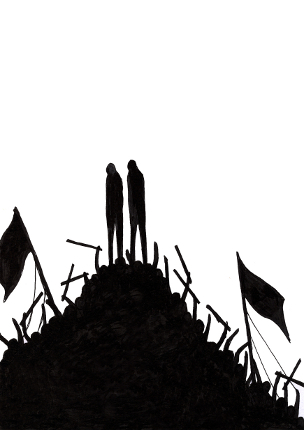In Visiting Japan / Hiroshima 2001 (2001) Van Houwelingen mixes private photographs with those taken in Hiroshima and Nagasaki shortly after the atomic bomb. While visitors of the country are forced by countless memorials and memorabilia to reaffirm the victimization of Japan during the war, Van Houwelingen questions this role of the victim by literally placing himself in the position of those remembered. Visiting Japan / Hiroshima 2001 can be seen as a journey to the center of violence: a radical identification with her victims an a reflection on its political instrumentalisation by the Japanese state.
In the running series De maakbare samenleving (2008-) (the socially engineered society) Staal combines text with simple drawings. Central to these pieces are the ever present human figures, black silhouettes involved in violent acts. Linked to the drawings are phrases like "de kiezer heeft altijd gelijk" (the voter is always right) connected with a scene of characters pummeling each other with bats. Another example is the word "Emancipatie" (emancipation) attached to an orgy scene in which a mass of these figures throw themselves on a few recipients. These works create a certain tension in the way Staal combines the vocabulary of progress and of the idea of a socially engineered society with images of violence, which seems to be the only real constant in human history.
The Plays of Cho Seung-Hui: Richard McBeef (2010) by Staal and writer Vincent van Gerven Oei is a film recording of the theater play Richard McBeef (2010) and was performed by the theater group Wunderbaum. The script was left behind by Cho Seung-Hui, one of the so called "high school shooters": students that shoot their classmates, teachers and finally themselves. Typical to these cases are the manifests and other documents these shooters leave behind to contextualize their act and make them their own. The recording shown at TORCH is realized by video artist Jan de Bruin.
Biokip (2009) by Van Houwelingen shows the ten minute long death scene of his twelve year old chicken. Although she is not dead yet, for the world around her she might as well have been; while her fellow chicken scramble around in the background, insects are already finding their way to the dying animal. The video breaks with the expected peace of mind often associated with the concept of a 'natural death': the convulsions going through the animal, the moisture streaming from her beak and the tired last breath show a kind of violence that man often chooses to mask, but that remains the reality of any death.
